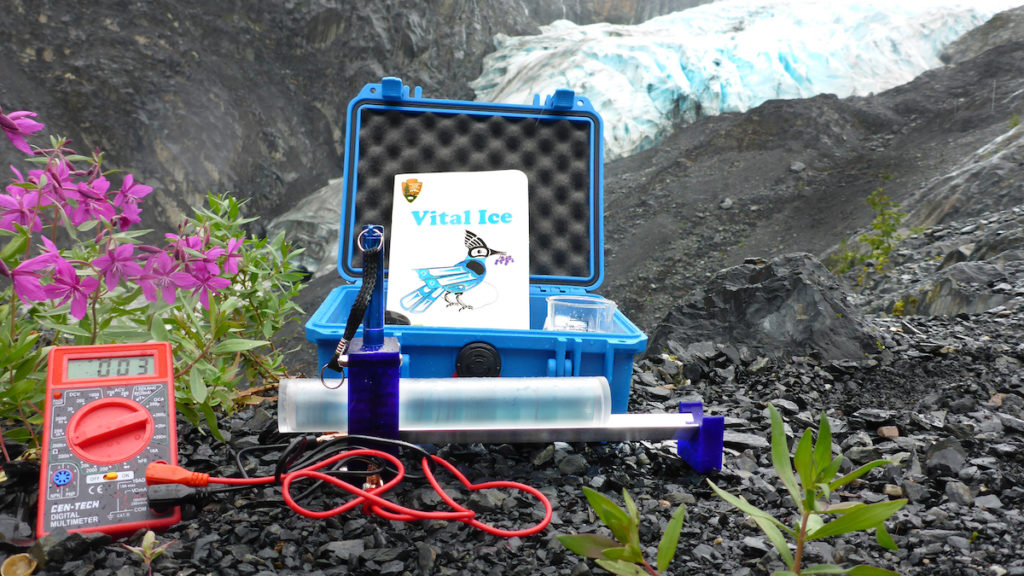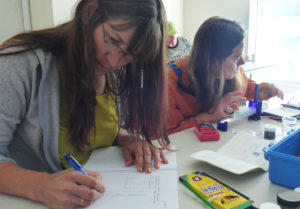
Some scientific fields lend themselves well to in-class activities.
Glacier monitoring is not one of those fields.
But the folks at the College of Natural Sciences Education and Outreach Center (EOC) traveled to Alaska this summer to learn more about how they could effectively adapt real glacier science to be portable for classrooms all over the country.
Tracking vanishing glaciers – from the classroom
In National Parks throughout the country, glaciers are receding due to climate change. We know this because scientists have been able to analyze ice cores taken from glaciers, which paint a picture of climactic patterns over the past 100,000 to 200,000 years.
Ice core samples, of course, don’t travel all that well. So how can the education specialists translate that science into activities any classroom can do? “We could just give them data on paper and say, ‘interpret the graph,’ but unfortunately, it is tough to engage students with data alone,” said Andrew Warnock, director of the EOC at Colorado State University. So he and his colleagues have devised a clever way to mimic a real ice core (extracted in 2013 from a glacier in Alaska and stored in the National Ice Core Laboratory in Denver) in a non-melting format. By creating frosted plastic tubes with embedded melt layers and chemical parameters, they were able to assemble classroom kits that students could use “giving them the experience of what an ice scientist would do,” Warnock said.
Students using the kit, titled “Vital Ice,” can scan their section of the “ice core” with a 3D-printed device that the EOC designed, sliding the core along an aluminum track to take readings with a meter. Gathering data as they go, students plot a graph showing patterns in the “ice” data. The brilliance of the kits is that each one in a classroom is different, presenting just one section of about 130 years’ worth of data from the real ice core. So after all of the measurements get made, student groups collaborate to match patterns to known climactic and geological events (such as volcanic eruptions) to assemble the full picture of the glacier’s story. And the findings are striking, Warnock says. Before the mid-20th century there were about 20 major melt events; since then, there have been more than 100! “The kit is not just relevant for Alaska, but for any parks that have glaciers, including Rocky Mountain National Park,” said Courtney Butler, assistant director of the EOC.
 This summer, Warnock and Butler traveled to Alaska to test the kit out at a teacher professional development workshop put on by the National Oceanic and Atmospheric Administration that brought together STEM educators and outreach groups from all across Alaska. They also met with local tribal elders, seeking to tie in local cultural relevance to the project.
This summer, Warnock and Butler traveled to Alaska to test the kit out at a teacher professional development workshop put on by the National Oceanic and Atmospheric Administration that brought together STEM educators and outreach groups from all across Alaska. They also met with local tribal elders, seeking to tie in local cultural relevance to the project.
“The Vital Ice kit was very well-received and generated a lot of excitement,” said Butler. Warnock added that they also got to experience life in Alaska outside of the classroom. “We learned about logistical challenges unique to remote regions of Alaska and how best to address the differences between traditional knowledge and science,” he said.
National Parks science for students
The new kit will join dozens of other classroom activities in the EOC’s lending library, from which teachers can check out a classroom set for free. The goal of the kits is to recreate ongoing scientific research and process in a contained kit that is easy for any teacher to use in their classroom. Most kits have come about by working with CSU faculty members to translate their research into a hands-on, student-friendly activity, such as studying marmot physiology or variations in guppies from Trinidad.
The development of this particular project was funded through a partnership with the National Parks Service. “The aim is to get park science into the hands of students – especially from schools that surround National Parks,” Warnock said.
This is the second kit the EOC has developed through the partnership. Previously, they developed a classroom kit around water conservation and saltwater intrusion in Hawaii. They now have hundreds of that kit in National Parks and in Kona schools.
The glacier project was chosen from a pool of 18 different parks that applied to work with CSU and the EOC. “It really came down to the culture piece, which park had the best cultural story,” Butler said. Warnock agreed, noting that “if you want to successfully engage local teachers with local parks, you can’t just do it with science – you have to also include the cultural side,” he said.
When this kit is finalized in the next year, it will be a vital addition in their lending library and the lending programs at Alaskan National parks, especially Denali and Kenai Fjords.